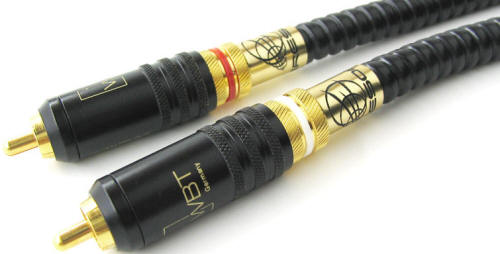
You are reading the older HTML site
Positive Feedback ISSUE
43may/june 2009
teresonic
Clarison Silver interconnects
as reviewed by Kent Johnson

|
KENT JOHNSON'S SYSTEM
LOUDSPEAKERS
ELECTRONICS
SOURCES
CABLES
ACCESSORIES SECOND SYSTEM
LOUDSPEAKERS
ELECTRONICS
SOURCE
CABLES
ACCESSORIES
|
I was contacted late in 2008 by Mike Zivkovic of Teresonic about reviewing Teresonic's Clarison Gold interconnect cables. I have to admit that I would certainly have enjoyed listening to these cables but, at $2985 per meter pair, reviewing them was another matter. A pair of cables, a 1 meter and a 2 meter for use in my main system, would cost as much as my main system! I thanked Mike but felt that such a review would not be of much benefit to PFO readers.
Mike then suggested that I review the Clarison Silver interconnects as an alternative. At less than 25% of the cost of the Gold cables, these were far more appropriate for my system and I readily agreed to do some listening.
Description
I find the appearance of the Clarison Silver cables to be very purposeful; they have a distinctly no-nonsense look to them. The black spiral outer jacket of each cable is made from PVC and measures 9mm in diameter. Contained within this jacket is a lot of technology. There is a steel/carbon (ferromagnetic) shield just inside the PVC. This encloses a pair of what Teresonic refers to as "interconnect blocks."
These identical blocks are comprised of a Teflon™ exterior, silver shielding screen, another layer of Teflon insulation, and a set of silver plated Litz conductors in the center. Air insulation makes up a good percentage of the interior volume of these blocks. Between the two interconnect blocks is what is referred to as a "fleet" cable by Teresonic. The fleet cable consists of Litz wiring with PVC insulation. This acts as an electrical screen between the two halves of the cable. This construction results in "full shielding against electrical, magnetic, and mechanical (vibrational) interferences," according to Teresonic.
Attached to each end of the cable are WBT 0110 Nextgen Copper locking RCA plugs. These plugs are minimally metal; their internal construction is primarily plastic. The locking barrels are aluminum.
The Clarison Silver cables are not marked as to direction. I was consistent in how I oriented them, however, just in case it mattered.
What I immediately liked about these cables was their flexibility. While hardly the most important quality a cable should possess, being flexible makes connections considerably easier.
The cables came in an embroidered cloth bag, which made for a very nice overall presentation.
Listening
I listened to the Teresonic cables exclusively in my main system. I used the 1 meter cable between my Sony SACD player and Dodd preamp; the 2 meter cable connected the Dodd to my Rogue 90 amplifier. I also listened with the Shengya A-216 hybrid integrated amplifier. This allowed me to use just the 2 meter cable directly from the Sony to the A-216. I auditioned the Clarison Silver cables while listening to GURU QM-10 and Quad 21L2 speakers. The majority of my listening was done, however, with my Magneplanar MG1.6 speakers.
The speaker cables used with the MG1.6s were my Alpha Core Goertz MI2 cables in a bi-wired configuration. A lot of different music was listened to with the Clarison cables. For serious comparison listening, I used SACDs. In doing so, I felt that I was listening to my system at its optimum sound quality.
So what did I hear?
The Clarison Silver cables did everything superbly that I consider audibly important. Namely the audio parameter—soundstaging, human voice, bass, midrange, treble, low-level detail, whatever—it was as good as I have ever heard from my system.
I value soundstaging very highly and the Clarison Silver cables provided as wide and deep a soundstage as I have experienced. Voices and instruments were solidly located in space and had their own three-dimensional integrity. Subtle inflections, whether of voice or instrument, were easily heard.
Female voices were beautifully presented. I listened to Diana Krall's Love Scenes (Impulse SACD B0002841-36) and The Best of Jacintha (Groove Note GRV1042-3) and enjoyed both of them immensely. There was lots of emotion, as well as detail, conveyed by their voices and the sense of either singer being in the room with me was very tangible.
The acoustic space of All Hallows Church, Gospel Oak, London, on Heavenly Harmonies (Harmonia Mundi HMU 807463) filled my listening room with the 13 distinct voices of the group Stile Antico. Here, both male and female voices were presented with a concreteness that made me feel that I was in the church with them. Their voices not only sounded utterly realistic but exceptionally intelligible as well.
Alban Berg is not a composer whose work I understand, although I am trying. Listening to Orchestral Works (Chandos CHSA 5074(2)) provided the opportunity to hear some large-scale performances via the Clarison Silver cables. Soundstaging was truly excellent making for a far better appreciation of what was happening within the orchestra itself. Low frequency instruments such as drums and bass violins had very realistic weight and impact. Violins had a dissonant quality to their presentation that made them emotionally edgy while never crossing into sonically edgy territory in the process.
Solo instruments were easy to follow. What surprised me about this music was finding myself anticipating what was going to happen next and occasionally being correct. Without fully understanding the music, I could still infer a very helpful sense of structure via the Teresonic cables.
Felix Mendelssohn's Piano Trios 1 and 2 (PentaTone Classics 5186 085) may appear to be far simpler music than the Berg but are intellectually every bit as profound. The Teresonic cables did an excellent job of allowing the violin, played by Julia Fischer, piano, and cello to be followed individually while maintaining the overall structure of the performance. Both the high frequencies, of the violin and piano, and low frequencies, of the cello and piano, were reproduced equally well and equally beautifully.
I recently purchased Handel Organ Concertos Opus 4 by the Academy of Ancient Music with Richard Egarr (Harmonia Mundi HMU 807446). I am not familiar with these concertos and was slightly disappointed by them. I expected the organ to come in and throw its weight around at some point and that never happened. The organ is confined primarily to its higher registers. Fortunately, the bass violin and cellos bring a satisfying weight to the performance.
Considered one of the best organists of his time—along with Bach—Handel performed these concertos between acts of his oratorios. Evidently, they were very successful both musically and financially.
The Clarison Silver cables provided the clarity and resolution needed to easily follow what each hand of the organist was playing. It sounds effortless but clearly takes a very skilled performer to bring off properly. I find that being able to both hear and follow these sorts of musical threads adds a great deal of enjoyment to the performance.
Summary
By any criteria that I could apply, the Clarison Silver cables were superb. To my ears they were extremely neutral neither adding nor subtracting anything from the music. Whatever limitations these cables may have—and I assume they have them or Clarison would not be offering their Clarison Gold cables as well—they were not revealed by my system.
Comparing the Clarison Silver Cables to the DH Labs Revelation Cables
Since my reference cables are DH Lab Revelations, also silver with high quality copper connectors, I thought I should mention how the two cables compared sonically. I know that if I were reading this review, it is something I would be curious about.
The fact that these cables sound far, far more similar than they do different should come as no surprise.
After extensive listening, I heard two consistent, extremely subtle differences between the cables. These were present with both amplifier set ups.
The Clarison Silver cables placed the front of the soundstage very slightly farther away from my listening position than the Revelation cables did. This difference was ameliorated virtually completely by simply playing the system louder by 1 or, occasionally, 2 decibels, depending upon the recording. (Thanks to the Shengya's 1dB volume steps, I was able to precisely ascertain the amount of additional volume needed.)
The other difference that I heard was a very slight edge on female sibilants with the DH Labs Revelation cables. The audibility of this difference was not consistent with either amplifier set up but varied with the recordings themselves. After considerable time spent listening, I concluded that the Clarison cable was actually the more neutral sounding of the two, at least to my ears and within the systems I used for my listening.
Summary of Comparison
The Clarison Silver interconnects are superb cables. I fear that I am going to need to so some serious upgrading of my system before their sonic limitations are likely to become audible.
I have saved the only negative comment I feel that I should relate regarding the Teresonic cables for last as it has both everything and nothing to do with their sound quality.
I found the WBT 0110 locking RCA plugs to be irritating to work with. They are hard to get a good grip on and difficult to tighten. The aluminum barrel and plastic threads of the Nextgen body just do not get along. In the confined spaces of my component rack, it was impossible to tighten them as securely as I would have liked. Fortunately, they never came loose or ever caused an intermittent connection.
While these RCA plugs are significant contributors to the superb sound quality of these cables, the difficulty of making a good mechanical connection with them is also the Clarison cable's one notable weakness.
That said, take the opportunity to hear these cables if you have the chance. I feel confident that you will find them as musically neutral and enjoyable as I have.
Should I ever accomplish any of the upgrades to my system that I would like to make, I am certainly not going to hesitate to ask Mike for a chance to hear the Clarison Gold cables as well. Kent Johnson
Clarison
Silver 1 meter interconnect
Retail: $685 per pair
Clarison
Silver 2 meter interconnect
Retail: $885 per pair
Teresonic
web address:
www.teresonic.com

